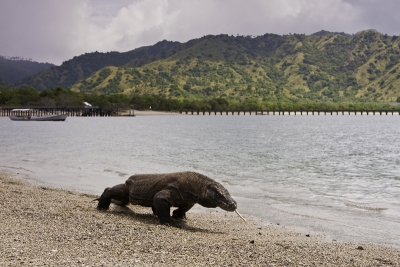
Situated in the central part of the Indonesian archipelago, the Komodo National Park spans an area of 2,00,000 hectares. A UNESCO World Heritage Site of Outstanding Universal Value, it is home to about 5000 Komodo dragons. As the only place in the world today with these lizards, the area has been of particular interest to both the scientific community and curious tourists. Once found in Australia too, these lizards are said to have thrived in their current home for millions of years now.
Wildlife
Though most noted for Komodo dragons, the park nurtures other wildlife too. Among the more than 70 species of birds spotted in the area are cockatoos, jungle fowl, kestrels, herons, thick-knees, doves, sunbirds, finches, drongos, Orioles, scrub fowl, and friarbirds. The waters around the boundary of the Park nurture several species of whales such as sperm whales, dolphins, sea turtles, and the endangered dugong also known as sea cow.
The “Jurassic Park” problem
Last October while several parts of the world were still grappling with COVID-19 and the destruction it left in its wake, a photo from the park went viral. What did it show? A Komodo dragon facing a truck. What was a truck doing in such an eco-sensitive region? This needs a bit of a history. In 2019, a controversial decision to close the Park was dropped after collective outrage. Soon after that came another piece of news. That the government would end mass tourism by imposing a heavily priced membership scheme to enter the park. “But around the same time they also unveiled plans for a mass tourist development on neighbouring Rinca Island, which is home to the second-largest population of Komodo dragons.” And this project has been dubbed “Jurassic park“, which is where Komodo dragon had an unexpected encounter with that truck. Concerned conservationists have raised questions over the need for such a project, worried that this move will ruin the natural habitat of the world’s largest lizard. A damaged natural environment will eventually affect its habitants too, meaning the Komodo dragons could be in peril if the project is completed. Though it has been said that the project has been stopped, media reports suggest that the project may not have been dropped but only paused for now.
Did you know?
- The world’s largest and heaviest lizards, these reptiles can grow up to 10 feet, weigh more than £300 and live up to 30 years in the wild.
- Going by their diet, they are hearty eaters –it is said that in one go, these giants can consume nearly 80% of their body weight. The carnivore’s diet includes everything from deer and pigs to water buffaloes and sometimes even smaller comes from its own species!
- Poaching and human encroachment are only two of the reasons that could lead to a decline in the population of these lizards.
- As with the most habitats the world over, climate change is unlikely to spare this region either. While resultant intense wildfires can directly alter the habitat of the Komodo dragon, storms threaten to cause extensive damage to corals and the reefs in the waters surrounding the archipelago.
Picture Credit : Google



